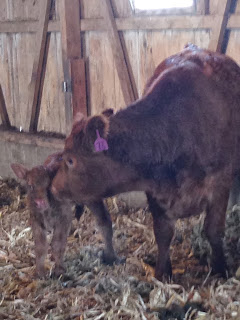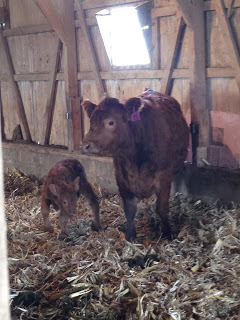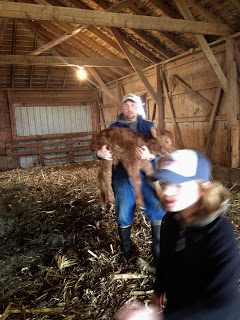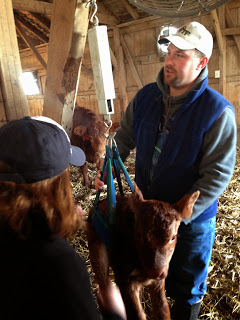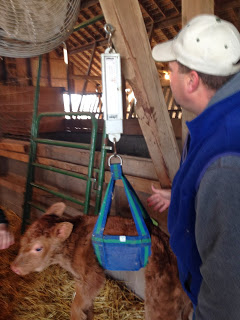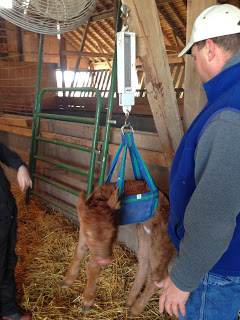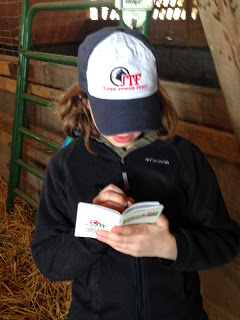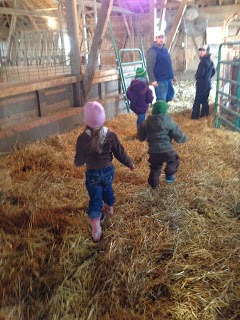 |
| The kids were excited to go see the new baby. |
Momma is a very calm heifer. She didn’t make any fuss at all of the extra attention. That’s the kind we like to see!
After a calf has nursed its mother the first time, it’s ready to be processed. After bringing the calf over the the processing area, we start off by dipping the calf’s navel in a solution of antiseptic solution and water. This kills any bacteria around the navel, which is a common entry point for infections. We also give a shot of vitamins B and Selenium. This gives the calf extra “pep” that gets them active during their first few hours of life.
Next, we weigh the calf. Birth weight is an important piece of information, as it is a very hereditary trait. Statistics are generated on all registered animals based on production information such as birth weight, ease of delivery, and weaning and yearling weights that help to compare an animal’s value. If you have a bunch of calves coming from a particular bull, tracking birth weight can help you know what to expect from the cows that have yet to calve.
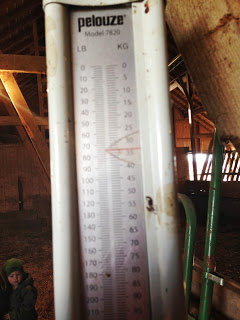 |
| 72 pounds. An ideal weight for a first-time calver. Cows can have calves that weigh between 60 and 110 lbs. |
Next we give the calves their own ear tag. The purebred cattle will get a tattoo that matches the number on their tag. The tag has their ID number- this one is W1B. The W is for Webel, 1 is the first calf of the year, though you don’t need to use sequential numbers, just something that differentiates the animal from the others in your herd. Finally, the B is used in all cattle across all breeds that are born in 2014. Last year used “A”, this year uses “B”, etc. The ear tag also has the mother’s tattoo number, 28LZ, so I can pair up the right calf with the right cow if needed, and finally, the father, or sire’s, name is written on the tag as well. STF Quigley is the sire of this calf.
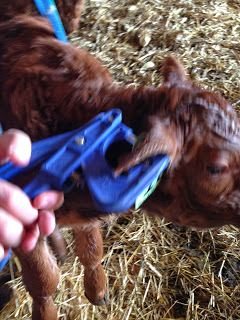 |
| Applying the tag. |
The most important part of collecting the information is recording it. Here, Anna is writing all of the information about the calf in her herd book. This information will then get registered with the American Simmental Association, via their online herdbook.
| Showing the girls how to fill out the calving recordbook. |
We’ll do this process about 130 more times this year, hopefully. 27 heifers are due to start calving the first week of February, then 105 cows start calving the first of March. During the first two to three weeks of March, we’ll likely have 3 to 7 calves per day. If the weather is nice, this will take place out in the pastures, otherwise the calving barn will be a busy place.
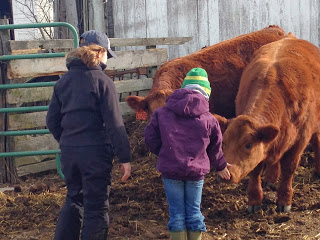 |
| Anna shows Josie the heifers that she’ll show this summer. |
| The kiddos, in their appropriate ag-related hats! |
Have any questions about this? Joe is happy to answer. I was just standing there, snapping pictures, so if your question involves things like, “what type of boots were you wearing, Emily?” or “was it cold?” I can handle those…
